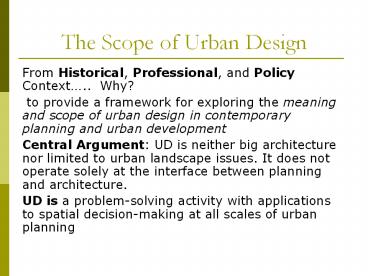The%20Scope%20of%20Urban%20Design - PowerPoint PPT Presentation
Title:
The%20Scope%20of%20Urban%20Design
Description:
to provide a framework for exploring the meaning and scope of urban design in ... Team X in 1953 exploring new low- and medium rise, high density interwoven urban ... – PowerPoint PPT presentation
Number of Views:221
Avg rating:3.0/5.0
Title: The%20Scope%20of%20Urban%20Design
1
The Scope of Urban Design
- From Historical, Professional, and Policy
Context.. Why? - to provide a framework for exploring the meaning
and scope of urban design in contemporary
planning and urban development - Central Argument UD is neither big architecture
nor limited to urban landscape issues. It does
not operate solely at the interface between
planning and architecture. - UD is a problem-solving activity with
applications to spatial decision-making at all
scales of urban planning
2
Urban Design Definition
- UD at its broadest, UD is about the form of
cities. We may regard it as that element in the
planning process that is concerned with finding
an appropriate physical framework for human
activities in cities. - Urban form may be viewed in two or three
dimensions, depending on the scale or level of
resolution at which the design process is
operating.
3
The Scope of Urban Design
- The need for UD as a discipline has arisen as a
result of the fundamental cultural, political,
social and economic changes. - Other issues include the impact of environmental
issues and quality of life on the nature of the
city and how urban form can best be adapted to
our current and future needs. - It has proved difficult to provide a simple,
commonly accepted definition of the scope of UD
4
Origins of Recent Urban Design Theory
- Urban Planning was introduce to place a growing
body of theory and practice in suitably general
geographical context. - Urban was a description of what had become a
culture and life style rather than a particular
geographical territory. - Urban Planning could comfortably accommodate
city, town and suburb, no matter how these were
administratively defined or physically
constituted.
5
Origins of Recent Urban Design Theory
- Paul Sprieregaen Urban Design the Architecture
of Towns and Cities was published in 1965 The
conventions of urban planning at this time
favored rigidly-defined, functionally-zoned urban
development. - This was influenced by the International Modern
Architectural Congress (CIAM) set up in 1920s in
Europe by Le Corbusier, Walter Gropius others. - Some of their ideas a wholesale renewal of the
contemporary city through zoned, single-use
high-rise developments. - At the same time, organic view of urban form,
originating in the English Garden City movement,
was being developed in the United States by
Olmsted, Mumford, Perry and others. This
suggested a regional model of the city,
decentralized, low-density and more suburban in
character, hierarchically organized on the basis
of semi-autonomous community-based neighborhood
units or super-blocks
6
Origins of Recent Urban Design Theory
- In the United States in 1960s, the economist Jan
Jacobs published her powerful critique of modern
town planning in The Death and Life of Great
American Cities, bringing the attention to the
complexities of land use arrangements, and
high-density living in traditional city blocks
and the shared activities of the traditional city
street in a new light.
7
Origins of Recent Urban Design Theory
- Defectors from CIAM formed Team X in 1953
exploring new low- and medium rise, high density
interwoven urban structures that would allow
opportunities for social exchange and encounter
that the international style excluded. This laid
the theoretical basis for an approach to urban
renewal which emphasized vehicular and pedestrian
separation
8
Origins of Recent Urban Design Theory
- In the 1950s, Kevin Lynch at MIT began to devise
new techniques for analyzing and representing the
perceptual structure of cities His work, The
Image of City, 1964 helped give rise to a new
science of human perception and behavior in the
city. - Later, Scott Brown and Robert Venturi published
their book Complexity and Contradiction in
Architecture questioned the International style
and advocated the catholic (conservative)
approach to the use of architectural styles and
symbolism
9
Origins of Recent Urban Design Theory
- Ideas of a morphological approach to UD was
explored by Colin Rowe of Cornell University and
others in Europe. The basic idea was to maintain
and restore the traditional 19th century street
pattern and form of urban block, street square,
without constraining the contemporary
architectural expression of new building
additions. - Aldo Rossis the Architecture of the City, 1989
introduce the notion of the collective memory of
the city with urban form as a repository of
culture from generations past and from
generations to come. - Rob Krier in his book Urban Space, 1984 sought to
catalogue all possible forms of urban space
generated from the geometric fundamentals of
circle, square, and triangle.































